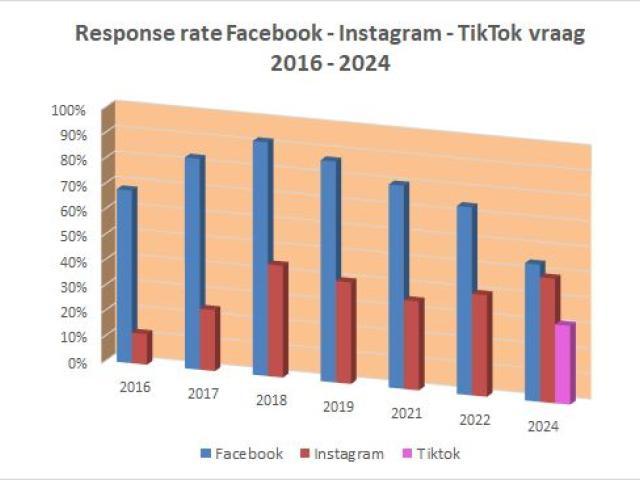
Social Media engagement in tourism: opportunities remain untapped
03/18/2025 - 14:52
- Expertise
- Industry
- Research
Majority leave questions unanswered
For the seventh year, research has been conducted on how companies respond to consumer questions via social media. This research, in collaboration with students from Tourism Management, focused on companies in tourism, hospitality, aviation, and recreation using mystery posts. The main question: how quickly and substantively do companies respond when customers ask a specific question in a post?
- Instagram: only 49% of companies answer questions within five days
- Facebook: the response rate has dropped from 92% in 2018 to 54% in 2024
- TikTok: only 31% of companies respond to questions at all
In other words, the majority of companies leave questions unanswered, while social media is all about interaction and engagement. The results are not an isolated incident: the same research has been conducted for seven years, and it still seems that 'posting' receives more attention than monitoring.
TikTok, new to the research this year, scores the lowest, despite its significant economic impact. Oxford Economics estimates the 'TikTok effect' by SMEs on the medium at 629 million euros.* The number of daily users is already around half of Facebook and Instagram users**. In short, the buzz around TikTok is enormous.
In this research, 'response rate' referred to the percentage of questions answered by the company within 5 times 24 hours.

Response rates from 2016 to 2024. (No survey in 2020 and 2023.)
Why responding is so important!
The research shows that consumers find it frustrating when their questions go unanswered. Notably, this 'non-response' is (almost) taken personally and has a negative effect on the customer experience. Moreover, social media algorithms favour engagement: the more interaction (including responses), the better a post performs. A company that actively responds not only increases customer satisfaction but also its visibility.
Additionally, a question is often a buying signal. If a consumer asks about opening hours, a special offer, or facilities, there is a good chance they are considering making a booking. By not responding, companies miss a direct opportunity to secure a customer. Furthermore, no company conducted a follow-up after answering a question: a missed opportunity in terms of customer retention.
The biggest irritations
The research indicates that companies are not only slow or absent in their responses, but the way they do respond can also be improved. Many consumers experience 'ghosting': they ask a question and then see the company continue to post new content without answering their question. This causes irritation among the researchers.
“It is disappointing to see that a company with 11 million followers and three posts a week does not take the time to respond to my question or other questions.”
Standard responses without further follow-up are also a common complaint. For example, replies like "We will contact you as soon as possible" without this actually happening. This leads to an even worse experience than no answer at all.
What do successful companies do well?
Fortunately, there are positive exceptions. Companies such as Diergaarde Blijdorp, Roompot, Turkish Airlines, and Lufthansa score well on social media interaction. What do these companies do differently?
- Personal responses: 80% of valuable responses are perceived as personal. A customer feels taken seriously when a company adds a name and specifically addresses the question.
- Quick responses: Although only 3% of companies respond within 15 minutes, customers usually expect a response within 24 hours. Companies with a positive social media policy strive to meet this expectation.
- Call to action (CTA): A good response includes a next step, such as a link to the website or a phone number. Unfortunately, only 31% of Instagram responses and 45% of TikTok replies contain a CTA.
- Public vs. private responses: Some companies respond via DM, which can be positive, provided this is clearly indicated in the post to the original question. Otherwise, it appears to other users that the company is not responding.
How can the sector improve this?
For companies focused on tourism, recreation, and leisure, there are enormous opportunities. Here are some practical tips:
- Establish a social media response policy: Clearly define who is responsible for answering questions and within what timeframe.
- Use monitoring tools: Platforms like Hootsuite or Brandwatch can help detect and respond to questions more quickly.
- Automate smartly: Chatbots and AI can assist with frequently asked questions, but ensure a staff member maintains control to keep the conversation personal.
- Train employees: Provide social media managers and customer service teams with clear guidelines on tone of voice and CTAs.
- Analyse and optimise: Measure response rates and continuously improve. A simple KPI could be: "Provide a useful answer to 90% of questions within 24 hours."
Conclusion: stop pushing and start the conversation
The current social media policy of many tourism companies remains stuck in one-way communication. Companies post plenty of content but forget to engage in conversation with their followers and thus potential guests or customers. This is a missed opportunity, both for customer satisfaction and commercial results.
Do you want to make a real impact on social media as a company? Then it's time to shift the focus from 'posting' to 'interaction'. Especially in the tourism and leisure sector, where experience and customer relationships are central, this can make the difference between an interested follower and a loyal customer.
7 years of response data
In the relevant research, 121 companies from the tourism, leisure, aviation, and hospitality sectors were examined through 149 mystery posts. These cases were created and analysed and compared with the past six years in a longitudinal study. Thanks to students of International Tourism Management at Breda University of Applied Sciences.
This article is based on a series of reports by Jeroen Vinkesteijn, lecturer and researcher at BUas. Under the name Creative Masters, he writes about social media engagement and reports on research results within the specialisations of e-marketing, social media, and aviation. Read the full articles (in Dutch) on Instagram, Facebook, and TikTok here.
*https://newsroom.tiktok.com/nl-nl/het-tiktok-effect-629-miljoen-euro-bijdrage-aan-nederlandse-bbp-dankzij-mkb-op-tiktok
**https://frescon.nl/wp-content/uploads/2024/03/Newcom-NSMO-2024-Basisrapportage.pdf